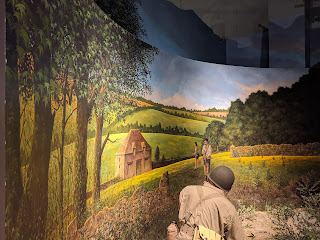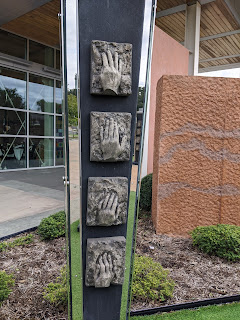After spending most of the morning in the South Carolina Revolutionary War town of Camden, Steven and I stopped just over the North Carolina state line in Rowland at what turned out to be a beautiful rest area for a picnic lunch.
On we drove next to the city of Fayetteville, North Carolina's most inland port and an early trade center because of its position at the head of the Cape Fear River. The city is known to most Americans as the home to Fort Bragg, one of the largest military bases in the world. We stopped at the (US Army) Airborne and Special Operations Museum which told the comprehensive history of that section of the armed forces from the original Parachute Test Platoon to the present day.
In the entrance was a nod to Napoleon Bonaparte who first conceived of a balloon invasion of England in the early 1800s. Though that never became a reality, toward the end of WW I the US Army Air Corps proposed forces to be dropped by parachute on the German-held French city of Metz in what became known as 'vertical envelopment.'
After Germany's invasion of Western Europe, there was a major build-up of training bases across the United States, including at Fort Bragg. The Nazi aggression was a clear signal that the US had to be prepared to defend itself.
Fort Bragg became a 'boom town' as workers poured into the state to begin construction of housing for thousands of new soldiers as the numbers ballooned from just 5,000 in 1939 to 66,000 troops in 1941. Seven hundred lumber mills throughout the Carolinas supplied millions of board feet of lumber and Fayetteville building suppliers became major companies as a result of the expansion.
The success of German parachute and glider forces in Belgium and the Netherlands in May of 1940 led to the development of similar units by the US Army. American forces were not successful with their Test Platoon until a major experiment was conducted at Fort Benning in Georgia during the late summer of 1940 which proved infantry could jump from an aircraft and conduct operations behind enemy lines.
The Provisional Parachute Group was established in early 1941 to recruit, train, and equip parachute units. The group was redesignated as the Airborne Command and stationed at Fort Bragg by 1942. In just three years, the Airborne Army consisted of over 100,000 parachute and glider soldiers.
Each of the British gliders contained a British folding bicycle and a 57 mm antitank gun. After D-Day, troops riding the gliders received hazardous pay because glider operations were so dangerous.
As an early supporter of unconventional warfare, President John F. Kennedy visited the Special Operations School at Fort Bragg in 1962. Special Forces provided an honor guard at his grave.
Troop in the 101st Airborne Division were sent to Little Rock, Arkansas, to ensure that court-ordered desegregation of Little Rock High School was fully carried out. Units of the 82nd Airborne Division were also deployed to Oxford, Mississippi, to back up another court order to admit a Black student at the University of Mississippi. Paratroopers from the 82nd Airborne were the first to arrive in Detroit after riots overwhelmed local and state authorities in 1965 and helped restore peace and order in the city.
The map detailed Airborne Combat Operations in Vietnam from 1965-1971.
Global Unrest from 1973-1982: The Army was compelled to reevaluate its airborne and special operations capabilities during a series of international crises in the 1970s. The crises ranged from the Yom Kippur War in 1973, unrest in Angola following independence from Portugal in 1975, to complicated political and military situations throughout Latin America. The Iran Hostage Crisis dominated American foreign policy for 444 days. A special operations rescue mission failed to free the 100 prisoners taken in November 1979 by enraged Iranians when they overtook the American Embassy. The Soviet Union's 'invasion' of Afghanistan the following month resulted in President Jimmy Carter issuing the Carter Doctrine that promised US forces would repel Soviet forces in the Middle East 'by any means necessary - including military force."
Our mentally exhausting visit to the Airborne & Special Operations Museum concluded with the involvement of special operations forces in Afghanistan shortly after the US learned that the World Trade Center attack on 9/11 had been orchestrated by Al Qaeda. Thank God, America's Longest War is now finally slated to come to an end by this 9/11.
If the museum hadn't been gutwrenching enough, we headed next to the North Carolina Veterans Park that was connected by a memorial path from the museum.
Though the visitors center was closed, we were able to spot through a window the massive chandelier made of 33,500 veterans' dog tags. That immediately brought home in a visceral way the service and sacrifice of so many brave men and women who put their lives ahead of ours.
The gently curving Oath of Service Wall displayed 100 cast bronze hands positioned at shoulder height symbolically taking the Oath of Service surrounded by their community. The oath was common to all branches of service and is the moment when veterans leave their communities to commit to service.
I read that each bronze hand was a life-sized casting from a veteran of every NC county to represent all veterans, past, present, and future who had and would take the oath of service. The hands were mounted to a wall that had soil from every county across the state. One hand was of the left only, representing the physical loss of the right hand that had been left behind in combat but which had once been held up proudly to take the oath.
Looking at the hands, we could only wonder at the innumerable stories that were reflected in skin and bone and shaped by time and experience.
The Preamble on the Service Grotto Wall consisted of a carved glass wall that faced a soldier's image under a sheet of water on one side that acted as a reminder of patriotism and a desire to serve the country.
Both the Sacrifice and Heroism companion sculptures represented the close relationship between the two ideals and were symbolized by the rectangular void in one piece that appeared in the other piece as the positive form.
The intent of the Honor sculpture, created from salvaged military materials, was to focus attention on a single point - "the pinnacle of honor and a moral compass." I thought it was brilliant that the sculptor used a gyroscope, an object that maintains its orientation regardless of what is happening around it in time and space, to suggest the pinnacle of honor.
The eight-foot slab of South African granite and a massive steel plate in the Commitment sculpture symbolized how two different parts "must work together, support one another, and be committed to each other as the troops support the country."
I read that the Patriot Wall had a vast field of stars etched in stainless steel so it could capture the reflections of people, art, water, sky, and the landscape in the middle of the Service Plaza. Just like each of us, each star was slightly different, with some polished, some textured, some complete, and some incomplete. Even so, the whole composition still appeared as a unit.
The Courage sculpture was created from actual salvaged military truck parts and symbolized two soldiers carrying their wounded friend back from battle.
Five arches, one for each branch of the armed forces, provided a visual and physical gateway from service life into the next phase of a veteran's story - life after service. The icons were a reminder that every veteran experienced transition in and out of service in a different way, each with their own memories of their experiences that shade their lives forever. The polished stars inside each arch gave us a glimpse of our reflection as we walked through to the Reflection Garden.
The garden was the perfect opportunity to admire and be forever thankful for those who choose to serve their country. By this point last September, Steven and I have been fortunate in visiting too many veterans' parks to remember. However, I am confident that we won't forget the NC Veterans Park in Fayetteville as its brilliant architecture and symbolism in literally every detail should be the gold standard for all state veterans' parks. I urge you to take time to go through both the Airborne and Special Operations Museum and the adjacent NC Veterans Park if you find yourself anywhere near Fayetteville. Though neither is an 'enjoyable' place because of their very nature, I did find myself uplifted by the values of sacrifice, honor, commitment, and heroism exemplified in both the museum and park.
We took a few minutes to wander around downtown Fayetteville including Market Square.
Posted at long last on May 19th, 2021, from our home in Denver as we soon leave for this summer's road trip. I had planned to have last year's posts completed ages ago but a combination of several road trips during the pandemic, an extensive home remodeling project, and lots of planning for an overseas trip this fall, then throwing out those plans, and coming up with a Plan B and finally a Plan C has put me well behind the 8-ball. Thank you for your patience as I plan to finish up last year's posts when I can.














































































No comments:
Post a Comment